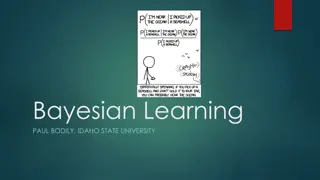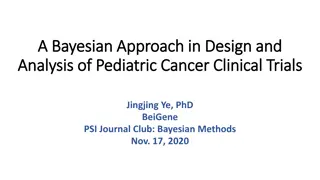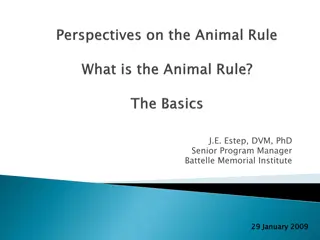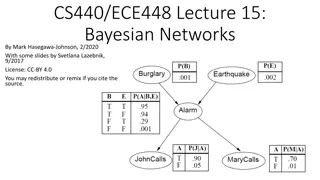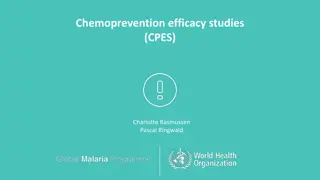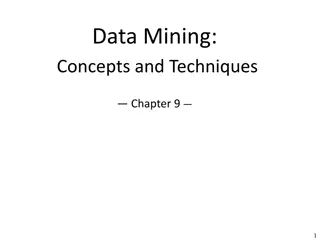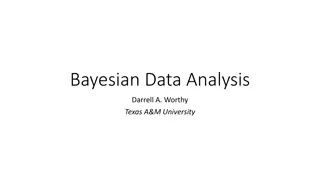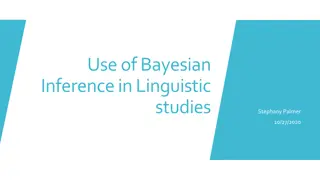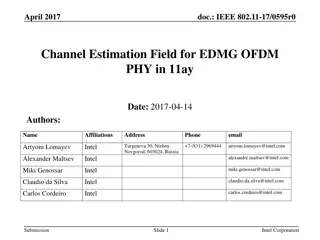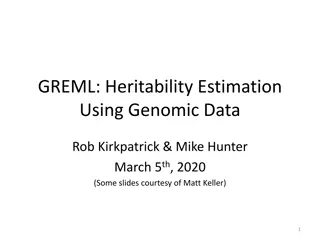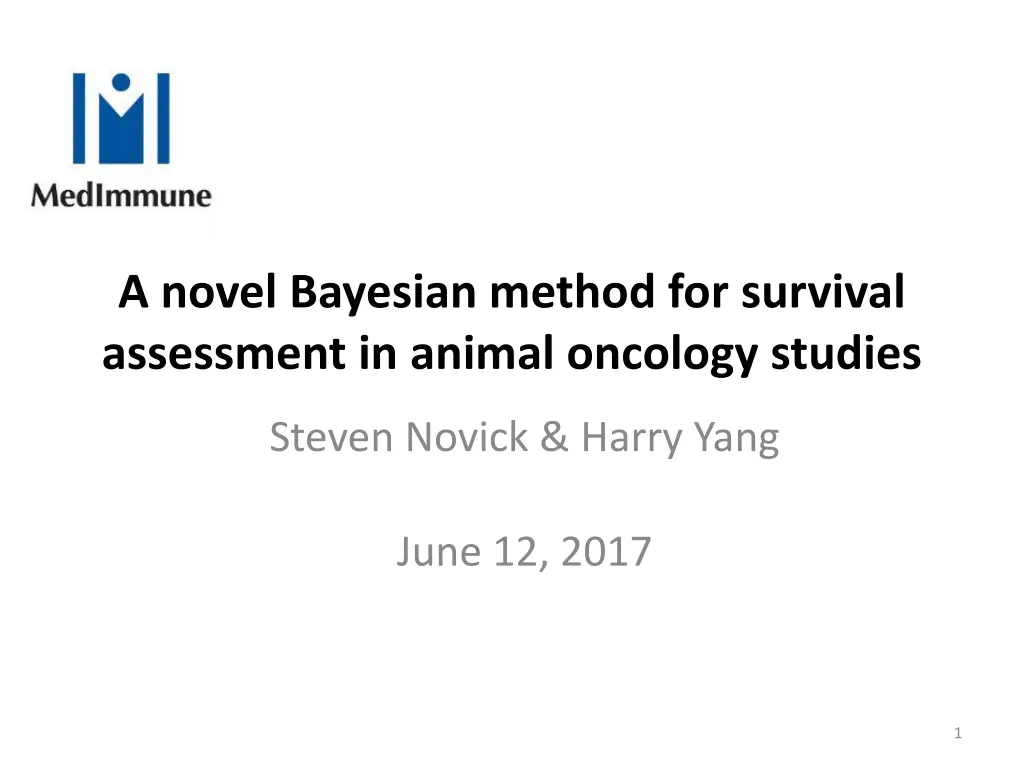
Bayesian Survival Assessment in Animal Oncology Studies
Explore a novel Bayesian method for survival assessment in animal oncology studies, focusing on tumor growth reduction with chemotherapy, different treatment combinations, and survival modeling strategies. The study involves syngeneic mice with tumors and evaluates various treatment groups over a specified timeframe using different survival models.
Download Presentation

Please find below an Image/Link to download the presentation.
The content on the website is provided AS IS for your information and personal use only. It may not be sold, licensed, or shared on other websites without obtaining consent from the author. If you encounter any issues during the download, it is possible that the publisher has removed the file from their server.
You are allowed to download the files provided on this website for personal or commercial use, subject to the condition that they are used lawfully. All files are the property of their respective owners.
The content on the website is provided AS IS for your information and personal use only. It may not be sold, licensed, or shared on other websites without obtaining consent from the author.
E N D
Presentation Transcript
A novel Bayesian method for survival assessment in animal oncology studies Steven Novick & Harry Yang June 12, 2017 1
Other manuscript co-authors Kris Sachsenmeier Ching Ching Leow (Lilly) Lorin Roskos In review: Statistics in Biopharmaceutical Research 2
Animal oncology studies Typically in mice or rats Goals: Reduce/delay tumor growth with chemotherapy and novel drug substances Monotherapy or in combination. Determine which treatments work best . 3
Oncology double-combination 60 syngeneic mice with tumors 6 Treatments (10 mice/trt) 3 monotherapy treatment groups: A, B, C 3 combinations: (A+B), (A+C), (B+C) Tumor volume measured at baseline (day 10) and every 3-4 days until day 84. Total # days = 74 Animal removed from study if Tumor Size > 2000 mm3 , severely ulcerating tumors, or > 20% loss in body weight. 4
Not always appropriate to compare tumor volume 6
Survival modeling Model the time to an event . For example, event: Tumor volume > 2,000 mm3 Tumor ulcerates Survival = have not experienced the event Efficacy is defined through the probability of survival at time t. 8
Three survival models strategies Non-parametric Kaplan-Meier (KM) (Kaplan and Meier, 1958) Semi-parametric Cox proportional hazards (CPH) model (Breslow, 1975) Parametric modeling Exponential, Weibull, log-logistic, etc. 9
Notation Survival function: S(t) = Pr( T > t ) ? ??? ? Hazard function: ? = /S(t) Median survival: t50. S(t50) = 10
Parameters i A parameter argument is added to indicate the treatment group. S(t | i) = survival function for ith treatment 11
Log-rank test Mantel, 1966 Typically paired with KM H0: h(t | 1) = h(t | 2) Ha: h(t | 1) h(t | 2) Issue Ranking? Two-sided test A B C 13
Median survival H0: t50,1 t50,2 Ha: t50,1 < t50,2 Ranking A < B, C Issue and B = C ? t50 > T* for treatments B and C 14
Parameter comparison H0: 1 2 Ha: 1 > 2 Cannot reliably estimate parameter for treatment C Ranking A < B C ???? 15
Our proposal: Relative survival Ederer, et. al. (1961) defined relative survival as the ratio of two specific survival probabilities at a specific time point. We extend the definition to the survival probability ratio of any two groups, given as S(t | 2)/ S(t | 1). 16
Proposed hypotheses H0: S(t | 2) / S(t | 1) r for some t1 < t < t2 Ha: S(t | 2) / S(t | 1) > r for all t1 < t < t2 Time interval: (t1, t2) may represent that latter of experiment 17
Testing paradigms S(t | 2)/ S(t | 1) > r log{S(t | 2)} log{S(t | 1)} > log(r) r = 0.9: Non-inferiority r = 1: Superiority r = 1.1: Superiority 18
Advantages Hypotheses are easy to interpret Hypotheses are not model specific Even when parameters are uncertain, survival model may be well estimated. May exclude early time points from testing (but not from model fitting) 19
Bayesian test statistic Test of hypotheses will be performed using a Bayesian posterior probability. p=Pr{ S(t | 2)/S(t | 1) > r for all t1 < t < t2 | data } Declare Ha if p > 0.95. 20
Relative survival H0: S(t | 2)/S(t | 1) 1.1 for some (2/3)T* < t < T* Ha: S(t | 2)/S(t | 1) > 1.1 for all (2/3)T* < t < T* Ranking A < B < C Power depends on model 21
KM Model ? ? = ?:??<?1 ?? ?? Parametric form ? ? = ?? ?:??<? ?? ?? ? ???? Likelihood: ? ? = ?=1 1 ?? 23
KM + our proposed method p=Pr{ S(t | 2)/S(t | 1) > r for all t1 < t < t2 | data } No closed form for S(t | 2) / S(t | 1) Calculated at a finite number of points. 24
Weibull parametric model ? ? ? ? ? = ??? Parameters =( , ) with = exp(x ) for covariates x ? 1 ? ? Hazard function: ? ? = ? 25
Consider the case 1=2=. Log hazard ratio: ? ?2 ? ?1 log = ? 1 log ?1 log ?2 Weibull model often paired with test of i. 26
Weibull + our proposed method p=Pr{ S(t | 2)/ S(t | 1) > 1 for all t1 < t < t2 | data } = Pr(?2> ?1| data ) p=Pr{ S(t | 2)/S(t | 1) > 1.1 for all t1 < t < t2 | data } = Pr ? ?1|???? 1 ? ??? 1.1 ?1?2? ?2 ? = ? ?1 ? 27
Hypothesis test S(t | 2)/ S(t | 1) > 1.1 for 50 days < t < 74 days Testing final 1/3 of trial time points 30
KM Model with 95% CIs Ranking: {A, C, A+C} < {B, A+B} < {B+C}. 31
Paired posterior probabilities A B C A+B A+C B+C A 0.00 0.09 0.00 0.25 0.00 B 0.97 0.97 0.12 0.94 0.00 C 0.37 0.00 0.00 0.14 0.00 A+B 0.99 0.22 0.97 0.98 0.00 A+C 0.63 0.00 0.18 0.00 0.00 B+C 1.00 1.00 1.00 1.00 1.00 Posterior probability that survival from the row is at least 1.1 times larger than the survival from the column 32
Weibull model Covariate = log-baseline tumor size Comparisons evaluated at the geometric mean baseline tumor size = 91 mm3 33
Weibull Model with 95% CIs Ranking: {A} < {C, A+C} < {B, A+B} < {B+C} 34
Paired posterior probabilities A B C A+B A+C B+C A 0.00 0.00 0.00 0.00 0.00 B 1.00 1.00 0.29 1.00 0.00 C 1.00 0.00 0.00 0.36 0.00 A+B 1.00 0.38 1.00 1.00 0.00 A+C 1.00 0.00 0.56 0.00 0.00 B+C 1.00 1.00 1.00 0.99 1.00 Posterior probability that survival from the row is at least 1.1 times larger than the survival from the column 35
Summary Novel method to compare survival curves based on relative survival. Works for variety of survival models. Permits superiority/non-inferiority testing Permits rank-ordering of treatments, even for small sample sizes. 36
Questions? 37
CPH Model ?(?|?) = exp ?0? exp( ), ?0? = baseline cumulative hazard function Parameter =xT for covariates x. ? ?? 0(?) Let 0? = Chen, et. al. (2014) describe model fit using gamma process prior for the baseline hazard function 0? and a normal prior for the parameters . 39
Note that ? ? = exp ? 0? . ? ?2 ? ?1 Since log = ?2 ?1is constant, CPH is usually paired with hazards ratio test. 40
CPH + our proposed method p=Pr{ S(t | 2)/S(t | 1) > 1 for all t1 < t < t2 | data } = Pr ?1> ?2 ???? }. p=Pr{ S(t | 2)/S(t | 1) > 1.1 for all t1 < t < t2 | data } Because ?0? is not estimated, we cannot test superiority. 41


